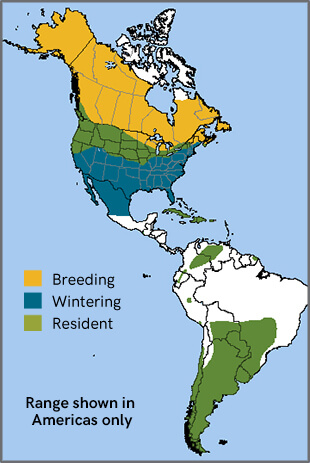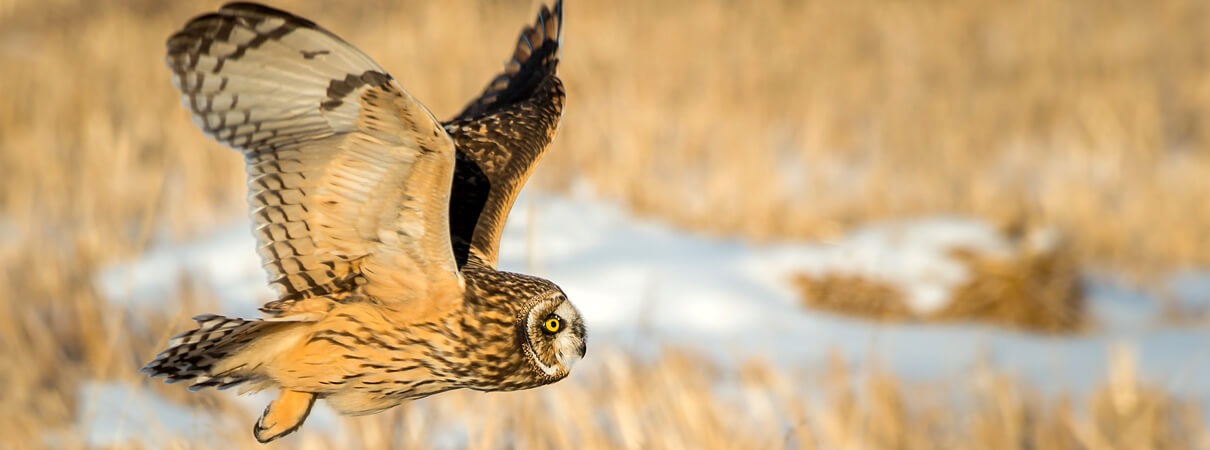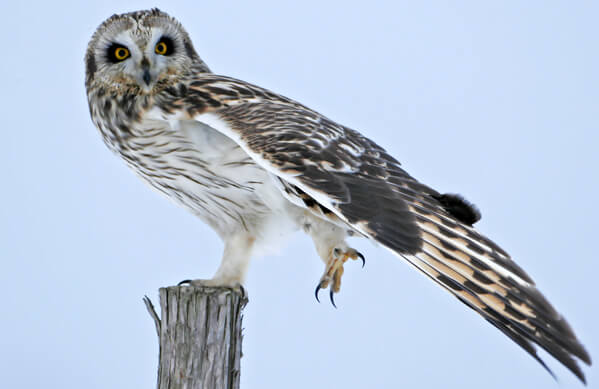
The Short-eared Owl's Latin name, flammeus, means “fiery” and refers to its boldly streaked plumage, which provides excellent camouflage in the open grasslands this bird favors. It is widely distributed around the world, with ten recognized subspecies. One of these, the Pueo, is Hawai'i's only native owl.
Flying over open terrain and often active during the early morning and evening, the Short-eared Owl can take on a markedly ghost-like appearance. Usually silent, the bird flies close to the ground with deep, slow wing beats that give it a buoyant quality.
Species of Strip-mines
The Short-eared Owl nests on the ground, usually in the shelter of a grass mound or under a grass tuft. Breeding habitat must have sufficient ground cover to conceal nests and support this bird's small mammal prey. In ideal habitat, the Short-eared Owl may nest in loose colonies.
This owl is one of the few bird species that seems to have benefited from strip-mining, where the open habitat resulting from mining operations may temporarily create the conditions needed for this ground-nester. Short-eared Owls have been found nesting on reclaimed and replanted mines well south of their usual breeding range.
Short-eared Owls can travel long distances and are found in many parts of the world, including North and South America, Europe, Asia, and many islands. Northern populations tend to be migratory and nomadic. During the winter, varying numbers of Short-eared Owls gather in areas with abundant food, and communal winter roosts of up to 200 birds have been recorded.
Short-eared Owl vs. Northern Harrier
Short-eared Owls hunt over open areas, hovering a few feet above the ground, then pouncing when prey is located. Their populations are closely linked to the population density of voles and other small mammals. Like other birds that depend on a fluctuating food resource — such as the Snowy Owl — the Short-eared Owl shows considerable local variation in its numbers and reproductive success.
Short-eared Owls and Northern Harriers often hunt in the same areas and harass each other when their “day shifts” and “night shifts” overlap. Harriers may even steal food from the owls. In the clip below, hear the bark-like vocalizations of two Short-eared Owls chasing a Northern Harrier; the harrier's calls are a rapid, high-pitched sequence of notes.
Audio by Bruce Lagerquist, XC344157. Accessible at www.xeno-canto.org/344157.
Snappy Courtship Display
Male Short-eared Owls perform eye-catching aerial displays, ascending hundreds of feet above the ground with rhythmic and exaggerated wing beats, hovering, gliding down, and rising again. This display includes “wing clapping,” when the male snaps its wings together below his body in a burst of two to six claps per second, often accompanied by yapping calls. The flight ends with the spectacular descent of the male bird, which holds his wings aloft and shimmies rapidly to the ground.
Other courtship displays include males locking talons and briefly fighting while in flight, or flashing their light underwings toward each other during flights.
Nests are simple scrapes built by the female, lined with grass stems and feathers plucked from her breast. Clutches may be as large as 14 eggs (but average five to seven), with large clutches laid during years of high food abundance. The ability to lay large clutches helps Short-eared populations recover after periodic declines. In southern areas, individuals may raise several broods a year. These owls also routinely lay replacement clutches when predation rates are high.

Short-eared Owl on the hunt by Ghost Bear, Shutterstock
The female does most of the incubation, with the male bringing food to the nest and occasionally taking a turn sitting on the eggs. After hatching, owlets grow very rapidly, and may begin to wander from the nest at only 12 days old, an adaptation that reduces the amount of time the young are vulnerable to predation.
Opportunities to Conserve the Short-eared Owl
Like other grassland birds, including the Long-billed Curlew, Mountain Plover, and Sprague's Pipit, the Short-eared Owl is threatened by habitat loss. Overuse of rodenticides and other pesticides also poses problems.
Other threats include collisions with cars, aircraft, and wind turbines. ABC's Bird-Smart Wind Energy Program emphasizes careful siting of wind turbines to prevent and mitigate collisions that affect Short-eared Owls and other raptors such as the Golden Eagle and Bald Eagle. ABC also continues to raise concerns about proposals for poorly sited wind developments throughout this bird's range.
We also work with partners to conserve grassland habitats across the Americas that are used by the Short-eared Owl and many other species, while our work in Hawai'i aims to prevent collisions that endanger the Pueo and seabirds such as the Newell's Shearwater and Hawaiian Petrel.
Donate now to help reverse widespread bird population declines!



















































